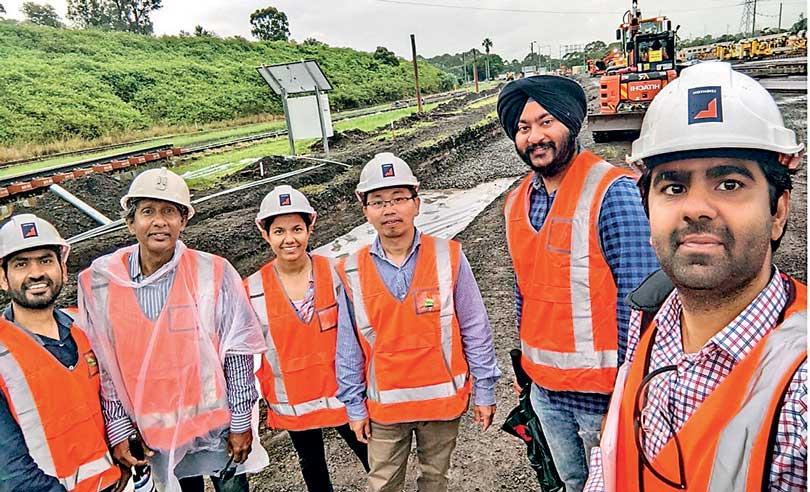27 Jan 2024 - {{hitsCtrl.values.hits}}

Prof Indraratna (second from left) with some of his research staff at a new rubber tyre foundation technology trial in constructing a rail track at the Chullora Technological Precinct
Photo by Buddhima Indraratna
The former University of Wollongong (UOW) Distinguished Professor of Civil Engineering, founding Director of the Centre for Geomechanics and Railway Engineering and celebrated innovator, Professor Buddhima Indraratna has been awarded the Order of Australia in the General Division of the Australia Day 2024 Honours List.
Prof Indraratna is perhaps best known for pioneering railway track research in Australia, and during his 29-year UOW tenure, inventing a railway shock absorption solution that could save the industry millions in maintenance costs and reduce the risk of derailments.
His research was concerned with transport geotechnics and ground improvement – how the geological conditions of railway foundations impacted the health and longevity of commuter and freight trains.
Born in Sri Lanka, Prof Indraratna was raised and educated in London and completed his PhD in Canada. Hailing from a family of doctors, he recalls how he was pressured by his late parents and former teachers to take up Medicine. But he had a passion for Engineering. Speaking to Australian media, Prof. Indraratna recalled how he was obsessed with infrastructure. “I was forever looking at skyscrapers, bridges and so on.”
At his first Engineering job for a British company, he was sent on a Dam Engineering Project to his native Sri Lanka, where he discovered a love for Geotechnical Engineering. This fascination with the problems of soils and rocks eventually segued into its applications in transport, which in turn led to a celebrated innovation. Prof. Indraratna therefore looked at using waste materials such as discarded rubber tyres to invent a railway shock absorption solution.
The geological composition under a railway track is often soft and requires compacted granular materials to stabilise the foundations before placing the ballast (the gravel or coarse stone used to form the bed of a railway track) along low-lying coastal areas.
Prof Indraratna’s solution involved reforming old rubber tyres into a honeycomb structure and filling each cell with compacted recycled waste materials ranging from building demolition waste to coal wash and even broken glass. Early trials suggested that the rubber based shock absorption system not only saved millions in costs but also reduced the risk of excessive track displacements and potential derailments. Countries such as China and India are looking at adopting similar technology.
Prof Indraratna and his research team have also introduced novel ways of improving conditions in the soft and compressible soils that pose significant challenges to the construction of railways, particularly in Australia’s coastal areas. He says the honour of the Order of Australia, awarded for his significant service to civil engineering, particularly through infrastructure development, ground improvement and transportation geotechnics came as a welcome surprise.
He said that awards of this kind reflect how the Australian government and its people appreciate technological advancements that would enhance the lifestyles of communities.
27 Apr 2024 7 hours ago
27 Apr 2024 27 Apr 2024
27 Apr 2024 27 Apr 2024
27 Apr 2024 27 Apr 2024
27 Apr 2024 27 Apr 2024